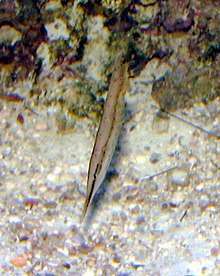Aeoliscus punctulatus
Aeoliscus punctulatus, also known as the speckled shrimpfish or jointed razorfish, is a member of the family Centriscidae of the order Syngnathiformes (the pipefishes and seahorses). This fish adopts a head-down, tail-up position as an adaptation for hiding among sea urchin spines. This fish is found in coastal waters in the Indo-West Pacific. Its natural habitat includes beds of seagrass and coral reefs, where sea urchins are found.
| Speckled shrimpfish | |
|---|---|
 | |
| Scientific classification | |
| Kingdom: | Animalia |
| Phylum: | Chordata |
| Class: | Actinopterygii |
| Order: | Syngnathiformes |
| Family: | Centriscidae |
| Genus: | Aeoliscus |
| Species: | A. punctulatus |
| Binomial name | |
| Aeoliscus punctulatus | |
| Synonyms[3] | |
Description
The speckled shrimpfish is a slender fish that attains a maximum length of 15 cm (6 in). Its snout is long and tubular and used to suck in its planktonic prey. Its body is flattened with a keel on the ventral surface and is covered in bony plates. The dorsal fin has three spines and ten to eleven soft rays and its anal fin has twelve to thirteen soft rays. It is a transparent pale greenish colour with a brown lateral stripe and a scattering of small black spots.[3][4]
Distribution
The speckled shrimpfish is native to the coast of East Africa and the western Indian Ocean. Its range extends from Algoa Bay, South Africa to Madagascar, the Red Sea, the Persian Gulf, the Seychelles and the Maldive Islands.[3] It is found intertidally on sandy flats and in seagrass meadows down to a depth of about 40 m (131 ft).[4]
Biology
The speckled shrimpfish swims in a head down position. It feeds on plankton and is found drifting in small groups in seagrass beds, among the branches of corals and the spines of long-spined sea urchins.[3]
References
- Cameron, C. & Pollom, R. (2016). "Aeoliscus punctulatus". The IUCN Red List of Threatened Species. 2016: e.T65134998A67618763. doi:10.2305/IUCN.UK.2016-1.RLTS.T65134998A67618763.en.
- Bailly, Nicolas (2013). "Aeoliscus punctulatus (Bianconi, 1854)". WoRMS. World Register of Marine Species. Retrieved 2014-01-01.
- Froese, Rainer and Pauly, Daniel, eds. (2018). "Aeoliscus punctulatus" in FishBase. February 2018 version.
- King, Dennis; Fraser, Valda (2002). More Reef Fishes & Nudibranchs: East and South Coast of Southern Africa. Struik. p. 28. ISBN 9781868726868.
External links
- Photos of Aeoliscus punctulatus on Sealife Collection
